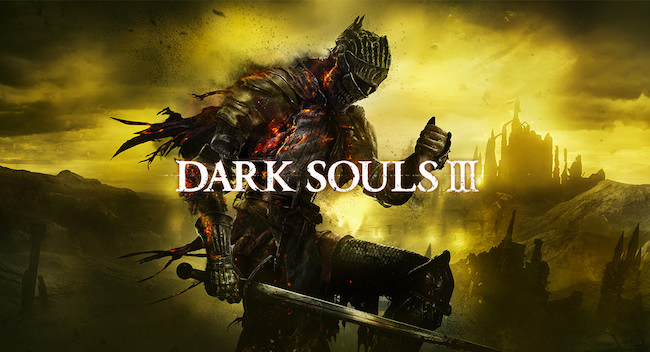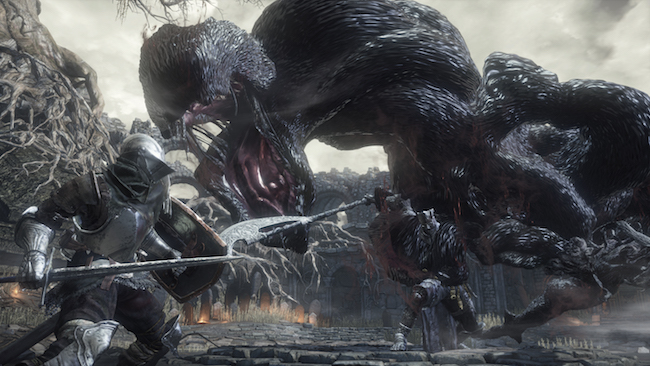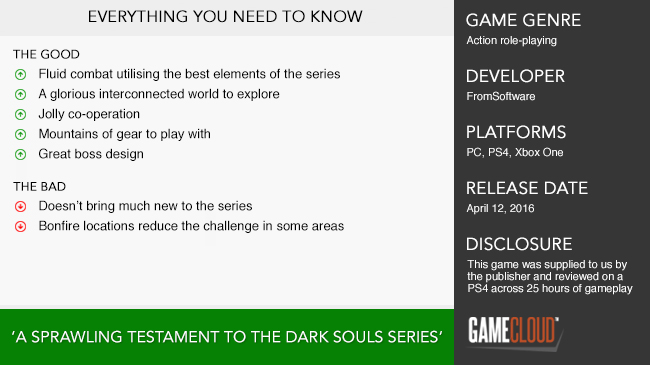
Dark Souls (2011) was a freak of a game that, despite all logic, was a massive hit. Its success was built on the cult following of FromSoftware’s previous title Demon’s Souls (2009), and its legend cemented by its superb, brutal gameplay. Although there has been a sequel and a “spinoff” (Bloodborne, 2015), Dark Souls is still the game all others are judged by. The interconnectivity of the world, punishing but fair gameplay, and obscure narrative all combined to create an incredibly visceral experience that the series has yet to surpass. Dark Souls 3 is a serious contender, and we’re unlikely to ever see that debate settled. We’re presented with an homage to the series most lovingly directed at Dark Souls, with all the best bits included while still managing to be its own game.

As a surprise to no one, Dark Souls 3 has you trapesing through castles and forests, slaying enemies and unearthing titbits of lore that in sum total forms its narrative. As the fifth in a series of games that has this exact formula it’s almost surprising that we’re still willing to come back for more, and all the more surprising that it’s still so damn good. The land of Lothric is fading and as the Ashen One players are tasked with returning (i.e. killing) the Lords of Cinder to their thrones to return fire back to the world. The story unfolds little-by-little through pieces of NPC dialogue and item descriptions, which then gives the landscape itself context. It’s an incredibly absorbing technique that doesn’t get in the way of the gameplay, while allowing players to engage with it as little or as much as they want. A lot of playful nods are made to the golden child of the series (Dark Souls) with plenty of familiar faces and themes, some more overt than others. I wouldn’t call this pandering to the fans, more an attempt to coherently wrap up (and expand in some cases) the plot of the first game. Where the lore of Dark Souls 2 felt disconnected from the first game and difficult to penetrate, this time there’s a clearer continuation of story that feels more satisfying.
Overall Dark Souls 3’s structure doesn’t diverge from the series’ roots (kill x amount of bosses to collect x amount of things to achieve the final thing), which is something I’d liked to have seen FromSoftware break out from as a last hurrah. Herein lies the mountain FromSoftware has to overcome – surprise. Souls games are all about the fear and trepidation of what lies ahead and what new ways the game has devised to murder you, and on this point Dark Souls gets it about half right. The first few hours in are classic ‘Souls, and fairly predictable. Anyone with a little experience in any of the “SoulsBorne” games will pick out oncoming danger (for the most part), which for some will minimise the challenge we’ve come to expect. That’s not to say this is a cut-and-paste job, nor that it’s dull or boring, rather a sign that players have adapted to Dark Souls’ special brand of masochism. Boss fights are a definite exception (mostly) with some new mechanics in play, and are still as entertaining/frustrating as ever.

Being a lover-letter to the series, Dark Souls 3 implements a whole pile of gameplay elements from previous games to make fighting (and dying) as fun as it’s ever been. Enemies drop souls, the game’s form of currency and experience points, all of which are lost on death. They can be picked up again, but if you die before reaching your corpse they’re gone for good. It’s a simple yet brutal mechanic to not just punish players for mistakes, but to also teach players to “git gud” in a rather heavy handed way. The first noticeable change is the return of the Focus Points (magic) bar from Demons’ Souls, which fuels spell and the new “stance” functions all weapons and shields have. The stance button activates the weapon or shield’s special ability that can range from special attacks to buffs or parries. This has huge implications for creating a wide range of inventive strategies and builds, while expanding the utility of your armoury. Charge up attacks from Bloodborne are a happy inclusion and while Dark Souls 3 allows for more defensive tactics than the former, the swordplay is smooth and quick enough for offensive play. An almost overwhelming amount of gear is thrown at players in a way that feels in a way the game is basically telling players to go nuts and experiment, rather than just relying on old faithful techniques.
One thing that is up for debate is Dark Souls 3’s difficulty. Previous title wasted little time in crushing players’ spirits and presenting brick walls to climb (looking at you Taurus Demon) quite early on in the game. For some, the first few hours of Dark Souls 3 are a walk in the park. The first mini-boss is far less threatening than he actually looks, and the bonfires that serve as checkpoints are surprisingly close together. The difficulty does eventually ramp up, but not in such a drastic spike as veterans might be used to. To be clear, this doesn’t mean this is a dumbed-down, casual Souls game. It’s just easy to feel bitter that new players to the series get an easier go of it, rather than bogging down in the first few hours of the game. Bonfires are placed a little too close together reducing the risk of losing hard earned souls when making the trek back to your corpse, one of the main causes of anxiety for any Souls player.

Something fans missed in Dark Souls 2 was the interconnectivity and sense of space Dark Souls managed to create. Bloodborne brought back some of this, but relied on fewer and smaller maps. Dark Souls 3 is relatively linear in what is essentially a one-way trek into the depths of Lothric with occasional forks in the road. There’s shortcuts-a-plenty to be found while not having the circular connectivity of the original, areas tend to loop back on other locations in logical ways. The brilliance of Dark Souls was in part due to how well the world was laid out. After playing enough through the game you start to realise that basically everything you can see in the distance is somewhere you can travel to, and you could even see where your dropped souls are from other areas. Dark Souls 3 gets close to reaching this level of space with huge draw distances that show just how far you’re come, and gives players just enough clues to allow them to navigate using landmarks. The different areas flow together in a meaningful way and give the land a much needed sense of being lived-in, and also providing insight into its downfall.
Little has changed when it comes to online play with the usual invasions and co-op summons, which are available to players who have burned an item called an Ember (called being Kindled). Players can invade other players’ games to basically ruin their day, or can be summoned from signs on the ground to help out. Covenants are back and a lot more versatile than before. Covenant items are collected along the way that can be swapped out in your inventory at any time, another sign FromSoftare wants to give players more freedom, to open up different multiplayer mechanics. Some summon other players to help when you’re invaded, and others reward you for invading. Passwords can be used to summon specific people, which is great, or if you feel like simply duelling just drop down a red summon sign. Again this is all part of the risk/reward system the series does so well, as the benefits of being kindled (extra health, able to summon allies for jolly co-operation) are weighed with the danger of being invaded. Playing offline eliminates this danger (except for scripted NPC invasions), but who’d admit to that?

For returning scarred warriors or soon-to-be-schooled newbies, Dark Souls 3 is a sprawling testament to the series and another triumph in game design. While a little of the gloss is starting to wear off as the series nears the verge of stagnation, it’s still an enthralling experience. I came into the game a little apprehensive as Dark Souls 2 left me underwhelmed and I wasn’t really sure I could do another gruelling death-filled slog through another Souls game. In a way the game’s directness in terms of its linear structure gave me a greater sense of purpose while I happily let FromSoftware pander to my Dark Souls nostalgia. The changes to combat gives you enough options to find your own playstyle and the new combat mechanics allow for all sorts of playstyles without messing up the game’s balance. There isn’t anything particularly new or groundbreaking introduced in Dark Souls 3, but what’s here is difficult to fault.











